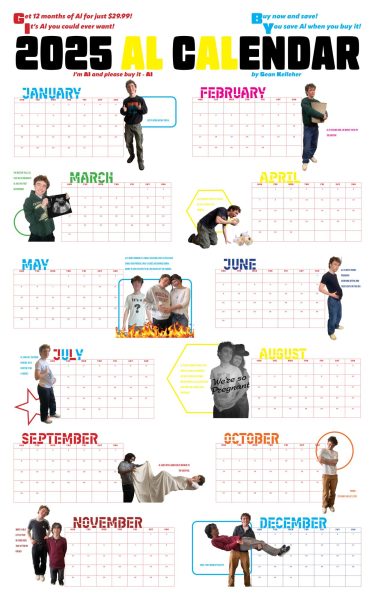Messenger University
The mission for admission.
Early Action: Typically Nov 1
Early Action 2: Typically Nov 15
You apply earlier and hear back from the college earlier than you normally would. It doesn’t lock you into any school.
(Restrictive early action is a type of decision that limits what other schools you can apply to if you apply in that way. For example, applying Restrictive Early Action to Yale means you can’t apply early to any other private universities.)
Early Decision: Typically Nov 1
Same conditions as EA, but if you get in, you HAVE to go.
Rolling Decision: No set deadline
You can apply whenever, but if you apply too late spots will fill up. They inform you after a set deadline.
Regular Decision: Varies
Plain old vanilla decision. You apply to a college by their specified deadline and hear back by their specified deadline.
Standardized Tests
Testing has never been fun, but this year it was a NIGHTMARE. Several students had to drive as far as Idaho just to take standardized tests due to a combination of high registration and closures of testing centers in Seattle. The added uncertainty of which schools would or wouldn’t be requiring test scores this year only worsened testing anxiety. In this section we’ll go over the basics of the SAT and ACT, whether it’s necessary, and the privilege that comes with taking it.
To start, let’s talk tests. In case you didn’t know, all the questions on both the ACT and SAT are multiple choice, aside from a couple questions at the end of the math section on both tests in which you bubble in numbers instead of choosing from five a-e options, and the optional essay at the end of the ACT (more on that later). The SAT consists of three separate, timed sections, beginning with 52 reading questions which you’re given 65 minutes to complete, followed by 44 writing questions (35 minutes), and topped off by 58 math questions (80 minutes).Since College Board discontinued the optional essay for the SAT after the tests in June this year, the whole length of the test is 3 hours, not including breaks in between sections. So aside from the brief 35 writing questions, you get well over a minute per question. The ACT, on the other hand, has four separate sections, only one of which you get exactly a minute per question.
The first section is English, for which you’re given a whopping 75 questions and just 45 minutes to complete it, followed by 60 math questions (60 minutes). After a short break, you’ll start the reading section, which is 40 questions and 35 minutes long, followed by a science section of the same length. Again, it’ll take around three hours to take the ACT without the essay, taking into account the usual delays and chaos of trying to cram 30 high-schoolers into a room that seats 15. When it comes down to which one to take, the ACT is arguably harder, if only because you are given less time to answer each question, but the actual content is about the same. The English/reading/writing sections consist of questions that test both grammar rules and reading comprehension and the science section on the ACT is also reading comprehension; little to no outside scientific knowledge is required. The math sections differ the most between the two tests. Most of the questions will be about algebra, but the ACT also has some trig and geometry questions thrown in there. On the other hand, the ACT allows you to use a calculator throughout the test, whereas the SAT’s math section has certain parts that specify where you are and aren’t allowed to use one.
Testing Privileges
One of the many privileges that is associated with standardized testing is money. For any under or upperclassmen who don’t know, it costs $52 to take the SAT and $70 to take the entirety of the ACT ($55 to take it without the optional essay portion at the end). To provide some context on the necessity of the essay, 678,906 out of 16,892,000 students across public and private high schools in the U.S. paid the extra $15 to take the essay in 2020, which is roughly four percent, according to US News. This year, due to the limited availability at testing centers, the cost of traveling was more of a factor than ever. Getting to most testing centers requires a car, but previously students could bus, walk, or bike. When the only available location is somewhere like Olympia or Auburn, however, it’s hard to justify the cost of gas or lodging. Tutoring for the tests doesn’t come cheap either; it varies by organization, but you’ll probably be spending anywhere from $45 to $100 per hour (insane, we know). All in all, testing can be a valuable tool, but when we consider the costs of taking the test even once, is it really necessary?
It’s pretty easy to say no and move on. Even before COVID, many schools started to make the transition to a holistic testing policy (meaning they ignored test scores when considering your application), and now, in the wake of the virus, few schools will require you to send them your test scores. BUT! That doesn’t mean you shouldn’t take it. If you don’t have the resources, don’t stress! If you have the means however, it would benefit you to make use of that privilege. You might end up getting a great score, which never hurts your chances. At the end of the day, it’s up to you. (766)
Letters of Rec
While academic achievement is important for the college acceptance process, acing tests and making the honor roll isn’t a guaranteed golden ticket. The way you present yourself to the college of your choice is also an important factor. In this section, we’ll go over the benefits and problems associated with letters of recommendation.
It’s rare to find a college that doesn’t require at least one letter of recommendation aside from your school counselor, and every college will suggest you have at least one or two letters from teachers, coaches, or other non-family-member-authority figures. Most teachers will agree to write a letter for you, but that’s not the problem (make sure to give them at least 3 weeks notice in advance, though, and be appreciative!). The hard part is finding a teacher to say something that is unique to you, and will highlight your best qualities so that you stand out from the thousands of people applying at the same time. So, when you’re thinking of who to awkwardly ask to shower you with compliments, here’s some advice: find someone who has watched you grow since freshman year, someone who can speak to the person who you were then and the person you’ve become. Advisory teachers are great for this! Keep this in mind the next time you feel the urge to roll your eyes or ignore them, because you’ll most likely have them every year of your high school career, and, if you play your cards right, they’ll be able to write you a killer letter of rec when the time comes.
Off the beaten path
Maybe your dream of playing college sports started the first time you kicked a ball, or maybe you’re already a talented artist who’s been coloring outside the lines your whole life. Your college journeys will be different from most, but are just as valid. The process for a prospective athlete or future Picasso relies on grit, persistence and honestly, a little luck. In this section we’ll go over the benefits, added pressures, and challenges of devoting your college experience to your one true passion. As most athletes, artists and academic scholars will tell you, if you love what you do, you’ll never work a day in your life.
Working to promote yourself and display your skill in a college application or to a recruiter is grueling. According to the NCAA, about one in thirteen high school athletes, or seven percent, go on to play a varsity sport in college and less than two percent of high school athletes go on to play at NCAA Division I schools. This isn’t unique to sports. The acceptance rate for art schools like Parsons and Cal Arts are thirty five percent and twenty five percent respectively. This isn’t to say it’s impossible. For the people who manage to beat the odds, the reward is great. Academic aid given to athletes to accommodate their busy schedules has improved over the years. Some athletes at certain colleges now have access to tutors for every class, specialized meal plans, and care for their physical and mental well being.
Having something that sets you apart from the crowd is also a great resource for getting into a highly academic or expensive school. The scholarship opportunities for artists with impressive portfolios are much more vast than someone with the same grades, essay and test scores without a portfolio. The same goes for athletes: the average athletic scholarship is about $18,000 per Division I student-athlete, based on numbers provided by the NCAA. This number can increase or decrease based on need and how much a school wants you to play for them. The people pursuing their passion in a college setting may seem very different from the average student, but all of our journeys are authentic. (369)
Final Thoughts
We know this is a lot! We tried to put together a comprehensive list of what we believe to be the most important things to know going into the application process. Unfortunately, we are only two of many people going through the college process (and only one of us is a senior) so your experiences will be very different from ours. No two people’s experiences will be the same, and that’s okay. We all think of college as THE end goal, something that everyone has to go through if they want to be successful, but if college isn’t in the cards for you, you’ll live! It’s true that college is important for many, but it’s not the end of the world if you don’t get into your dream school, or any schools; there’s always next year. You can make any school you go to a great school, so make sure to listen to yourself if you feel like a school isn’t the right fit for you in terms of people, place, or other factors that may make your life there unappealing. First and foremost, listen to yourself throughout the whole undertaking; don’t let your friends or family influence where you apply to or end up going. So, keeping all this in mind, we wish you luck and support as you turn the page to the next chapter of your life (we couldn’t resist the cheesy sentiment) (you can clap now).

Lucy is a junior at GHS. she has been with the messenger since the 2021 school year. she has done many articles for the NFO section of the paper and...





